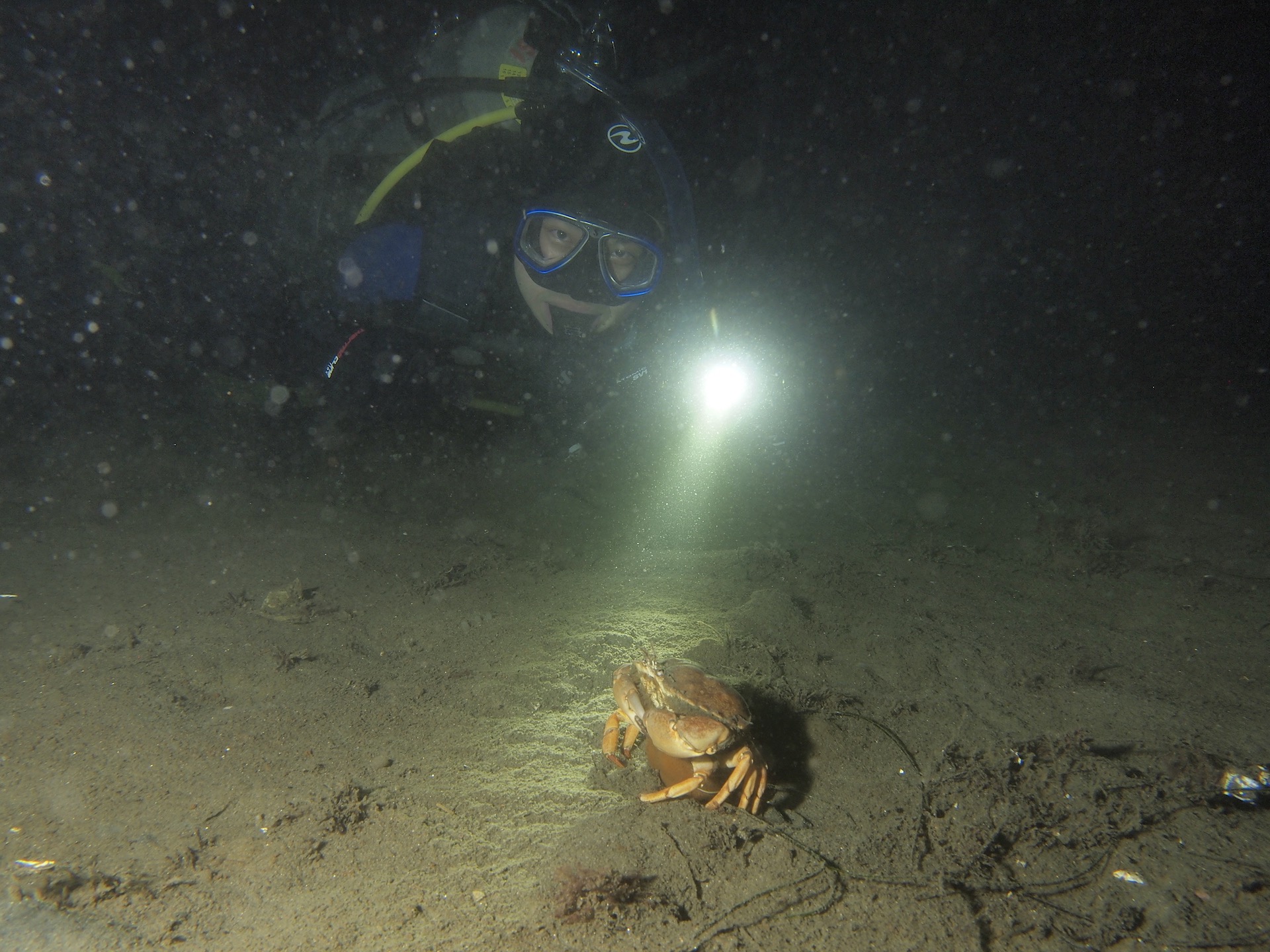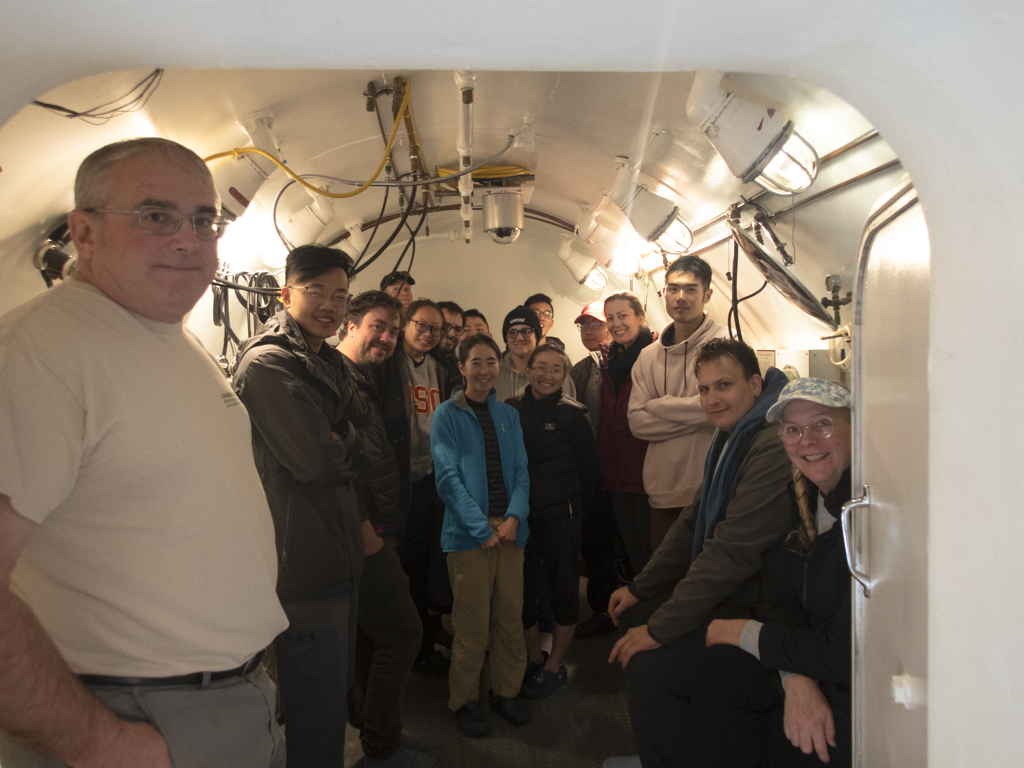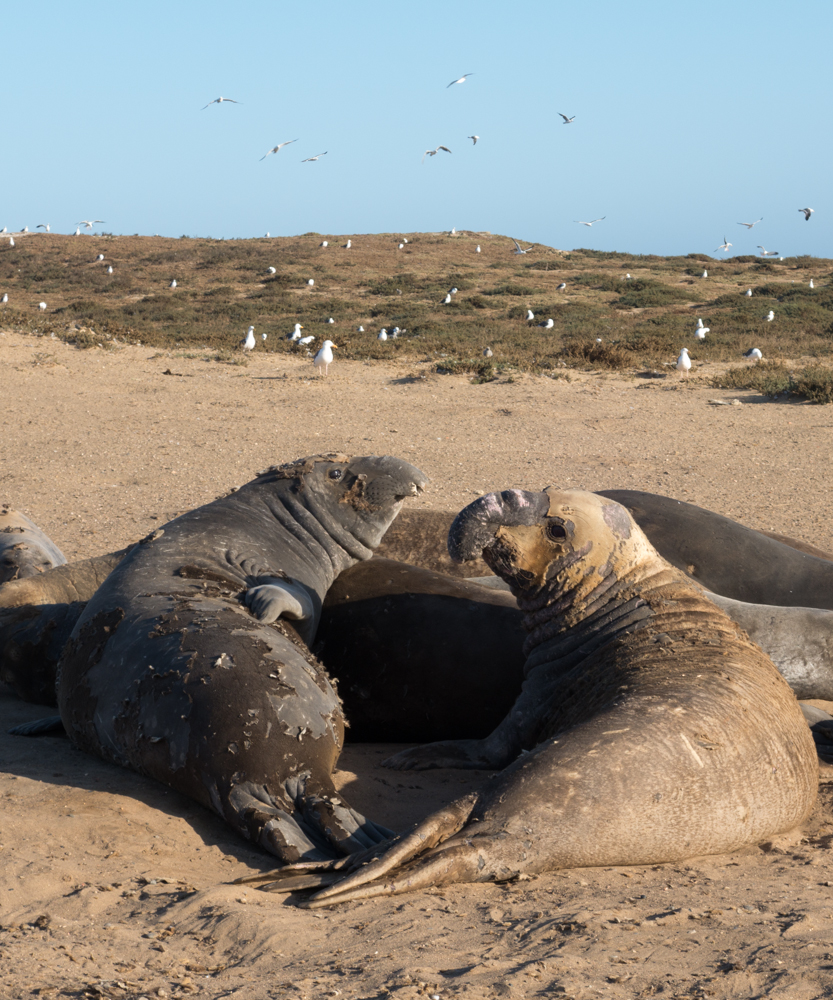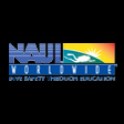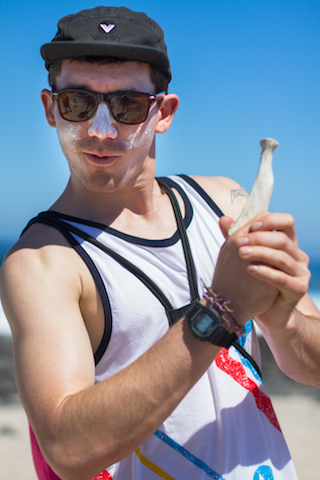
Galvin Thomas Templar
Occupation: nstructor Trainer
Location: Atlantis
Hometown: Temple City, CA
Born at the tender age of zero, he began his first migration towards the great Pacific Ocean. Forged by the rough shell sand and pounding temperate waves, he formed a deep connection with the sea and all of her creatures. Now he uses his powers to teach others how to form a deep and lasting relationship with our mother, Ocean.
In his terrestrial life, he is most commonly spotted at the Ocean Safari headquarters answering calls, repairing equipment, orchestrating excursions, and signing autographs.
After hours he must travel to the nearest body of water to avoid desiccation, often spending his weekday evenings teaching scuba, free diving, and rescue diving at the Norman S. Johnson Aquatic Center in Arcadia.
When he is not “working” photography, music, surfing, and hiking are his go-to activities.
Though his powers are great and many, there are still countless migrations ahead.
Join Ocean Safari and view this majestic creature on your next underwater adventure.
Santa Cruz Sea Lions
August 12, 2021
On August 8th we had the privilege to dive around Coches pt of Santa Cruz Island. Water visibility was roughly 25-30' and surface temperature was near the mid 60's. The water was glassy and the channel crossing was super smooth. We decided to dive around the Coches point area where we enjoyed diving through lush boa kelp and playing with the local raft of juvenile sea lions.
Shaws Cove Morning Beach Dive 5/27
June 1, 2020
Our first dive activity after local beaches have been opened up was a beauty. We enjoyed the warmth from the sunshine as we discussed beach entry and exit techniques and watched the surf. Since it was everyone's first time doing a beach dive we practiced one entry and exit without scuba gear to get a feel for the surf. Once we started our dive we were immediately greeted by a very gregarious male sheephead who ended up joining our group for the majority of our dive. As we made our way along the point there were beautiful gardens of golden gorgonians growing all over the reef. We stopped to appreciate the morning sun shining on all the inhabitants of the reef, and spotted a spanish shawl laying eggs. There isn't a better way to start the day than with a healthy dose of vitamin sea. We all said our goodbyes energized and ready for the rest of the day.
March 14, 2020 Redondo Beach Night Dive
March 15, 2020
Aside from a little rain, diving conditions at Vet’s Park were optimal. I was surprised to see that we were the only divers there on a Saturday night. The visibility was easily 25’, surface temperature was 60F, and the swell was minimal. The five of us spotted several rays of varying species and small schools of fish while we kicked out on the surface. Our dive profile was pretty conservative for Vet’s considering that one can very easily get below 100 feet of water. We cruised, following the sandy bottom down from 20 feet to a max depth of 70 feet. During our 50 minute journey we had a lot of fun and came across all kinds of exciting creatures!
We were absolutely surrounded by prawn, crabs, turbans, tube worms, sand dabs, and everything else you can find on a sandy bottom in southern california. On top of all of that one of the first special guests we spotted was a spotted-cusk eel. We observed it sifting the sand with its whiskers for a while before it got annoyed of our lights and slipped tail-first into the sand. Just a few meters away from the cusk eel we found an adorable sarcastic fringehead who was posted up in an upside down turban shell. Luckily for me the fringehead was cooperative and posed for some photos! As we started to follow the bottom to shallower water we crossed paths with a halibut, a sole, and several types of rays.
One of my favorite things to see on a night dive is the bioluminescent algae sparkling in the water. The only way you can enjoy this phenomenon is for everyone in your group to turn off their lights. Prior to getting in the water we agreed on a signal to go lights out, and made sure that everybody was comfortable with it as well. Once the lights were out we spent at least 10 minutes playing in the dark before we turned the light back on and made our ascent. Every one of us was stoked after such a great dive, and I can’t wait for the next one!
Recreational Chamber Visit
January 22, 2020
Once a year we enjoy the privilege of capping off a trip to Catalina with a tour of the Wrigley Hyperbaric Facility. This year we were grateful to receive out tour from the director fo the chamber himself, Carl Huggins. As he showed us around the facility he explained where the chamber came from, why its important to us, and how it works. He also took the time to explain to us the reasons people end up in the chamber, and how we can prevent any non-recreational visits to the facility.
The need for the chamber arose after research divers got DCS and didn't have any options outside of commercial and military dive chambers. The chamber was donated to the county by the Lockheed company in the 1970's. It was originally used by Lockheed in their SR-71 and SST programs for the pilots who developed decompression sickness. Now a days this is not the only chamber available to us because hospitals are using them more and more to treat burns, carbon monoxide poisoning, and other serious wounds. The difference between the facility on Catalina Island and the chamber sin hospitals is the size and the dedication of this facility to treat diving accidents. Catalina chamber is supported by donations from local divers and companies. It only has one full time employee, and is staffed with a team of volunteers. With out the support of the volunteers and donations for the community we would not be able to have this great facility to take care of us in the event of decompression illness.
The 2 dives we had before the chamber tour were fantastic. We were lucky to have the sun out for both our dives, 40' visibility, and 60 degree water. We intended to dive at bird rock for our first dive but arrived to find one dive boat live-boating the site and two other dive boats anchored on both sides of the rock. We motored over to rock quarry to find super glassy surface conditions and a healthy bed of kelp that stretched out 200 yards down the cove. My favorite experience of this dive was gliding through the forrest with my advanced class and looking up through the kelp to see thousands of little black smith fluttering through the sunlight. After we were all back on board we went back to Bird Rock, but the wind was picking up and white caps were starting to form. To play it safe we left it for another day, and tied up at the mooring on Lulu's reef where the water was also glassy. When we got in the water I was happy to feel there was a slight current, which means that more fish would be out and about. We experienced a unique phenomenon of thousands of pyrosomes floating around and piled up on the floor all around the reef. It was really fun to see them fly up into the water as the vortex from peoples fins collided with the stacked up creatures.
Pyrosomes are colonial organisms, which means each of the ones that we recognize are made up of millions of smaller organisms. They are bioluminescent at night and in the day time have iridescent pink coloration. They float freely through the water column filtering microscopic plant cells out of the water to feed them selves. All of the divers were amazed at what they saw, and many learned for the first time that this peaceful creature exists.
Diving the Pacific Side of Baja California
August 9, 2019
We came to Mexico to explore virgin pinnacles and coves of the Pacific side of Baja California,. We began in Cabo San Lucas by cooling off in the Sea of Cortez with hundreds of Mobula rays. These large groups are called Fevers. While we swam with the fever we enjoyed a lovely view of the famous arch just outside the marina. With the sun up and a water temperature of 79 F some of our group went in with just their shorts and rashguards. Our boat drivers would drop us off right in front of the swimming rays so that we could swim among them. They seemed to move very slowly, but were much faster than they looked! When we weren’t admiring them underwater we would watch them fly up to 10’ out of the water and slap their wings and body back down onto the surface. After about 2 hours of snorkeling we headed back to the marina to gather the rest of our belongings and head to our home for the next 10 days, the Nautilus Undersea Hunter.
Once we all boarded the vessel we were offered a cheese plate and sushi rolls as a late night snack. The galley and common area was very cozy with 2 big couches, and 2 big dinner booths. Our lead dive master, Sten greeted us and introduced a few other crew members to us while also filling us in on important boat details. Sten, who is a good friend of Gabriel sic Ocean Safari, and one of the most experienced divers familiar with Baja California. Along with him we have 2 more of the best dive masters in Baja California, Ivan and Ray. Each of them with over 20 years and thousands thousands diving experience. Due to the exploratory nature of this expedition, our schedule was not set in stone. We would start by sailing towards the most remote and difficult to reach destination on our agenda, Rocas Alijos. Through the night we motored north against the swell, which continued through the first day at sea. The total time to reach Rocas Alijos from Cabo San Lucas is roughly 34 hours. Due to the weather on the open ocean it wasn’t safe for snorkeling, so we spent our first 2 days preparing our equipment, doing yoga, cross fit, tai chi, laughing, and sharing stories with each other. Everyone was in a great mood because we knew we would be making it to the seldom seen, and even more seldom dived on, Rocas Alijos.
On the surface were three towering rocks spread out over a 200 yard area. The largest of them stood 110’ tall. Sten told us that many years ago rebreather guru, Jeff Bozanik, climbed to the top of the rock while they were here together on a dive trip. Today you can see some sort of weather station surrounded by many birds right at the top of the rock. Several of us were wondering what method was used to instal the weather station. Our questions were answered during our last few hours at the rocks when what appeared to be a Mexican Navy ship appeared on the horizon. She sent out a helicopter which hovered above the weather station and lowered 3 people down onto the rock. They did a great job and everyone enjoyed watching them work. Before we left we witnessed the erection of a shiny new Mexican flag.
Visibility underwater was at least 100’ and the water temperature was 70 Fahrenheit. The swell was about 4-7 feet, and the period was around 12 seconds. For our group of well seasoned, world traveling divers, the conditions were extremely enjoyable! We saw dozens and dozens of Galapagos sharks, and a myriad of different fish species. The topography underwater consisted of vast boulder fields with 100’ tall monoliths sprinkled all around. On one of our dives we found a beautiful arch covered in big schools of cortes sea chub and black jacks. For me, this was the most exciting dive at rocas alijos. We started diving the underwater arch at roughly 100’ and slowly followed the formation up to the surging shallows at the base of the south east rock. On the morning of our second day of diving at rocks alijos we found a dozen of flying fish who had gotten stuck on our swim step. Dive master Sten collected them and we used them as shark chum on our following dives. On one of our dives we saw at least 50 young Galapagos sharks. We all made many fond and exciting memories diving rocas alijos. We bid farewell to these 3 giants of the pacific ocean and headed back towards the mainland to our next destination, Isla San Benitos.
Isla San Benitos greeted us with amazing clear indigo waters. Water temperature here was around 65F and visibility was between 80-100’. This is where we started to notice some familiar faces such as garibaldi, calico bass, and sheep head. There were also many new faces which we had not seen yet such as the guadalupe fur seals, sea turtles, and scythe butterflyfish. The terrain underwater was made up of scattered pinnacles covered in boulders and crevices which were abundant with marine life. The mild current and surge made the diving much more exciting and brought out all the fish. My fondest memory here was riding the surge on the exposed side of a large pinnacle and being visited by a curious guadalupe fur seal as we enjoyed the sunlight dancing over the rocks. Reluctantly we all said our goodbyes to Isla San Benitos and headed toward Isla Cedros.
Arriving at Cedros Island a bit later in the afternoon left us time for just one more dive before sunset. The water here had noticeably less visibility, but the temperature was still in the 60’s. The dive that we did here was shallow, with a maximum depth of 20’. The terrain was an expanse of jagged rocky reefs and boulders. Though we got here late in the afternoon the sun was still high in the sky, shining its light through the water and illuminated the green eel grass as it swayed hypnotically with the passing swell. We enjoyed the presence of dozens of horn sharks on this dive. I even observed one carrying its egg case through the eel grass, my assumption is that it was looking for a good place to place it while the baby inside develops into a shark. The scenery reminded me of diving at San Clemente Island, except that very very few people have ever dove where we dove at Isla Cedros.
The next Island in our path was Isla San Jeronimo. The diving here reminded me of Santa Rosa Island. The water was pretty chilly at a cool 53 F, and the water was a misty emerald. Despite the colder temperature and cooler water we enjoyed the beauty of diving in beautiful forests of giant kelp. There was an abundance of nudibranchs, sponges, and anemones as well. The terrain was very rocky and offered many canyons and nooks to explore. Near the surface we were lucky to swim with thousands of red pelagic tuna crabs.
After a couple dives we got back onto our pangas and headed for shore. A short hike on the island brought us to an old light house where we could gaze upon all of the surrounding shores of San Jeronimo. There were hundreds of roosting seagulls, wrens, and pelicans all over the ground. Above us were swirling masses of worried parents telling us to watch our steps as we hiked past their hatchlings to the other side of the island. At a small beach opposite of where we landed we had an excellent view of a colony of elephant seals. They didn’t seem to mind our gawking, but once in a while blew their noses into the dirt to let us know they noticed our presence.
Our last dives were at Isla San Martin. Though this Island was further north than Jeronimo, the temperature was significantly warmer at 58F. The color of the water was still that same misty green, but we had even more kelp here. Inside the kelp was like a beautiful cathedral where rays of sunlight penetrate the tiny gaps between the kelp canopy. There were about a dozen harbor seals curious following us everywhere we swam. While we were here we also saw a team of lobster divers hard at work.
Our journey from Cabo San Lucas had finally come to an end when we reached our port in Ensenada. The experiences that I shared with our divers and the crew were one of a kind, and left me wanting to come back for more. I am very grateful that we made it to such remote destinations like the fabled Rocas Alijos. I’m also grateful for having such fantastic company and food for the journey. In order for this trip to happen it took many years of planning, and a team of divers who were willing to try their luck at exploring the magnificent pacific coast of Baja California.
Squid Run
January 9, 2019
Over the years I have heard stories from many divers about their amazing experience diving with squid at one of our local beach dive sites. The squid are only here for a brief time, and in order to dive surrounded by these intergalactic cepholopods you must be at the right place at the right time. One perk of working in a dive shop is becoming privy to information about dive condition and local marine life sightings, so I was able to get the scoop on when and where they could be found. The night that I decided to try to find these squid also happened to be my partners and mines anniversary. Luckily for me she is also a diver, so when given the choice between a sit down dinner or a 30m night dive she happily chose the latter.
By the time we had packed our gear and hit the road it was about 7pm, and we would arrive at the parking lot about an hour later. The name of the dive site is Vets Park, and is a Los Angeles beach diving staple. I debated bringing my giant camera rig into the water, contemplating about how annoying it would be to lug it around with no squid to film. I asked a group of divers exiting the water if they saw any squid, and their answer was a disheartening “Only a few. just in the tens and hundreds, not the hundreds and thousands. Maybe tomorrow or Saturday would be better.” Ten and hundreds still sounded pretty good to me so I decided to bring my rig. As we walked towards the beach I spotted my good friend Erich coming back from his dive. He happily showed me some pictures and video and told me that they saw tons of squid. Erich also told us roughly where along the beach to enter and how deep to go.
We walked down the beach towards the pier and entered the water. Tonight the surf was small, but you could feel the energy of the swell underwater. We made our way down to about 90’ where we started to see the occasional squid. Being both of our first times, this was already very exciting for us. The squid were completely alien looking creatures. Big eyes, tentacles, and pulsing translucent bodies flew through the blackness of the water. Eventually we were greeted by huge schools of squid flying by us, many of them interlocked with each other. We also observed the squid building their eggs into little nest like piles. Surrounding these eggs were hundreds of small target shrimp scarring over the floor.
It was such an amazing experience that we decided to join our other friends on Saturday night with hopes to see even more squid. We didn’t see more than five squid this time, but did see piles of squid eggs strewn all over the sandy bottom. Hiding in and around the eggs were tons of sting rays, as well as more target shrimp.
Here is a short video I made with the footage I gathered from both nights.


